Scientists stumble upon a surprising finding in their efforts to enhance desalination processes: 'Remarkably convenient and budget-friendly'

View pictures in App save up to 80% data.
Researchers at the University of South Australia have made a major breakthrough in addressing global water scarcity, according to Tech Xplore.
While more than 70% of the Earth's surface is water, most of it resides in the oceans, making it unsuitable for drinking. Currently, approximately 36% of the world's population lacks access to freshwater for a minimum of four months annually, and this figure could potentially double in the next few decades, according to Tech Xplore.
Still, the ocean blue presents an opportunity: seawater can be evaporated, stripped of the high salt content that makes it unusable, and then turned into safe, drinkable water.
Would you consider installing hydropanels for water collection on your house?
Absolutely!
I'm uncertain.
Absolutely not!
If the funding comes from the government
Select your option to view the outcomes and share your thoughts.The problem with this thermal desalination method has always been the large amount of energy it needs and the slow rate of evaporation. That's where the study's findings, published in the Advanced Materials journal, come in.
The researchers successfully increased the evaporation rate of seawater, achieving a rate that is 18.8% greater than that of pure water. Previously, seawater's evaporation rate was 8% lower than that of pure water, marking this development as a significant milestone, according to Tech Xplore.
In order to achieve this remarkable result, scientists introduced a mixture of minerals into the tank c